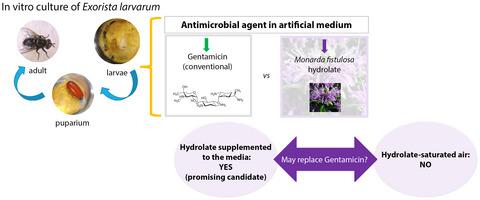当前位置:
X-MOL 学术
›
Entomol. Exp. Appl.
›
论文详情
Our official English website, www.x-mol.net, welcomes your
feedback! (Note: you will need to create a separate account there.)
Monarda fistulosa hydrolate as antimicrobial agent in artificial media for the in vitro rearing of the tachinid parasitoid Exorista larvarum
Entomologia Experimentalis et Applicata ( IF 1.4 ) Pub Date : 2020-09-13 , DOI: 10.1111/eea.12964 Maria Luisa Dindo 1 , Monica Modesto 1 , Chiara Rossi 1 , Maura Di Vito 1 , Giovanni Burgio 1 , Lorenzo Barbanti 1 , Paola Mattarelli 1
Entomologia Experimentalis et Applicata ( IF 1.4 ) Pub Date : 2020-09-13 , DOI: 10.1111/eea.12964 Maria Luisa Dindo 1 , Monica Modesto 1 , Chiara Rossi 1 , Maura Di Vito 1 , Giovanni Burgio 1 , Lorenzo Barbanti 1 , Paola Mattarelli 1
Affiliation

|
Exorista larvarum (L.) (Diptera: Tachinidae), a larval parasitoid of Lepidoptera, can be reared from egg to fecund adult on artificial media composed of crude components. The standard in vitro culture is performed in 24‐well plastic rearing plates. Exorista larvarum eggs, removed from superparasitized larvae of Galleria mellonella (L.) (Lepidoptera: Pyralidae), are individually placed in the wells, each containing a cotton swab soaked in liquid medium. The plates are then sealed until parasitoid puparium formation. To avoid contamination by microorganisms, the artificial medium is routinely supplemented with 0.01% solution of gentamicin. Experiments were carried out to assess whether this broad‐spectrum antibiotic may be replaced with hydrolate of Monarda fistulosa L. (Lamiaceae), which was selected due to its high in vitro activity against pathogenic microorganisms for humans and plants. The hydrolate was either supplemented to the artificial medium (0.5% wt/wt) (first experiment) or placed in an empty well (200 μl) of the rearing plate, to be supplied as saturated air due to evaporation (second experiment). In both experiments, a standard medium with gentamicin and an antimicrobial‐free medium were maintained as positive and negative controls, respectively. In the first experiment, in the hydrolate‐supplemented medium fewer E. larvarum completed egg‐to‐adult development than in the standard medium, but significantly more parasitoids developed from egg to adult compared to the antimicrobial‐free medium. No significant difference was found between the numbers of eggs laid by the females obtained from the standard medium vs. those from the hydrolate‐supplemented medium. In the second experiment, the hydrolate‐saturated air significantly decreased E. larvarum egg hatching, puparium formation, and female fecundity compared to the standard medium. In perspective, M. fistulosa hydrolate supplemented to the artificial media for E. larvarum may be considered as a promising candidate to replace the gentamicin solution, as suggested also by the microbiological analyses of the media, performed at various growth stages of the parasitoid in a separate trial. Conversely, the hydrolate‐saturated air treatment was deemed unsuitable.
中文翻译:

Monarda fistulosa hydrolate 作为人工培养基中的抗菌剂,用于体外培育 tachinid 寄生蜂 Exorista larvarum
Exorista larvarum (L.) (Diptera: Tachinidae) 是鳞翅目的幼虫寄生蜂,可以在由粗成分组成的人工培养基上从卵培养到可繁殖的成虫。标准的体外培养在 24 孔塑料培养板中进行。从大蜡螟(L.)(鳞翅目:Pyralidae)的超级寄生幼虫中取出的 Exorista 幼虫卵分别放置在孔中,每个孔中都装有浸泡在液体培养基中的棉签。然后将板密封直至形成寄生蜂蛹。为避免微生物污染,人工培养基中常规添加0.01%庆大霉素溶液。进行了实验以评估这种广谱抗生素是否可以被 Monarda fistulosa L.(唇形科)的水解物替代,之所以选择它,是因为它对人类和植物的病原微生物具有很高的体外活性。将水合物补充到人工培养基中(0.5% wt/wt)(第一个实验)或放置在培养板的空孔(200 μl)中,由于蒸发而作为饱和空气供应(第二个实验)。在这两个实验中,含有庆大霉素的标准培养基和不含抗菌素的培养基分别作为阳性和阴性对照。在第一个实验中,在补充有水解物的培养基中,与标准培养基相比,幼虫完成卵到成虫发育的数量较少,但与不含抗生素的培养基相比,从卵发育到成虫的拟寄生物明显更多。从标准培养基中获得的雌性与雌性所产卵的数量之间没有发现显着差异。那些来自补充水合物的培养基。在第二个实验中,与标准培养基相比,水合物饱和空气显着降低了 E. larvarum 的卵孵化、蛹的形成和雌性繁殖力。从角度来看,补充到 E. larvarum 人工培养基中的 M. fistulosa 水解物可能被认为是替代庆大霉素溶液的有希望的候选者,正如培养基的微生物学分析所表明的那样,在寄生蜂的不同生长阶段进行单独审判。相反,水合物饱和空气处理被认为是不合适的。补充到 E. larvarum 人工培养基中的 fistulosa hydrolate 可能被认为是替代庆大霉素溶液的有希望的候选者,正如媒体的微生物学分析所表明的那样,在单独的试验中在寄生蜂的不同生长阶段进行。相反,水合物饱和空气处理被认为是不合适的。补充到 E. larvarum 人工培养基中的 fistulosa hydrolate 可能被认为是替代庆大霉素溶液的有希望的候选者,正如媒体的微生物学分析所表明的那样,在单独的试验中在寄生蜂的不同生长阶段进行。相反,水合物饱和空气处理被认为是不合适的。
更新日期:2020-09-13
中文翻译:

Monarda fistulosa hydrolate 作为人工培养基中的抗菌剂,用于体外培育 tachinid 寄生蜂 Exorista larvarum
Exorista larvarum (L.) (Diptera: Tachinidae) 是鳞翅目的幼虫寄生蜂,可以在由粗成分组成的人工培养基上从卵培养到可繁殖的成虫。标准的体外培养在 24 孔塑料培养板中进行。从大蜡螟(L.)(鳞翅目:Pyralidae)的超级寄生幼虫中取出的 Exorista 幼虫卵分别放置在孔中,每个孔中都装有浸泡在液体培养基中的棉签。然后将板密封直至形成寄生蜂蛹。为避免微生物污染,人工培养基中常规添加0.01%庆大霉素溶液。进行了实验以评估这种广谱抗生素是否可以被 Monarda fistulosa L.(唇形科)的水解物替代,之所以选择它,是因为它对人类和植物的病原微生物具有很高的体外活性。将水合物补充到人工培养基中(0.5% wt/wt)(第一个实验)或放置在培养板的空孔(200 μl)中,由于蒸发而作为饱和空气供应(第二个实验)。在这两个实验中,含有庆大霉素的标准培养基和不含抗菌素的培养基分别作为阳性和阴性对照。在第一个实验中,在补充有水解物的培养基中,与标准培养基相比,幼虫完成卵到成虫发育的数量较少,但与不含抗生素的培养基相比,从卵发育到成虫的拟寄生物明显更多。从标准培养基中获得的雌性与雌性所产卵的数量之间没有发现显着差异。那些来自补充水合物的培养基。在第二个实验中,与标准培养基相比,水合物饱和空气显着降低了 E. larvarum 的卵孵化、蛹的形成和雌性繁殖力。从角度来看,补充到 E. larvarum 人工培养基中的 M. fistulosa 水解物可能被认为是替代庆大霉素溶液的有希望的候选者,正如培养基的微生物学分析所表明的那样,在寄生蜂的不同生长阶段进行单独审判。相反,水合物饱和空气处理被认为是不合适的。补充到 E. larvarum 人工培养基中的 fistulosa hydrolate 可能被认为是替代庆大霉素溶液的有希望的候选者,正如媒体的微生物学分析所表明的那样,在单独的试验中在寄生蜂的不同生长阶段进行。相反,水合物饱和空气处理被认为是不合适的。补充到 E. larvarum 人工培养基中的 fistulosa hydrolate 可能被认为是替代庆大霉素溶液的有希望的候选者,正如媒体的微生物学分析所表明的那样,在单独的试验中在寄生蜂的不同生长阶段进行。相反,水合物饱和空气处理被认为是不合适的。











































 京公网安备 11010802027423号
京公网安备 11010802027423号